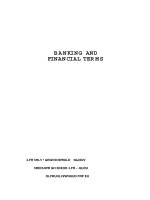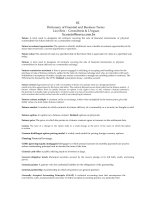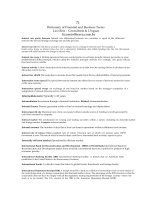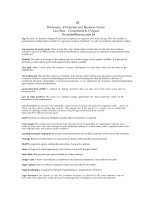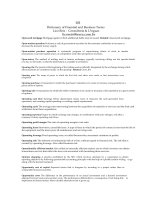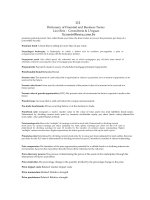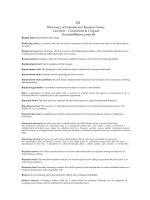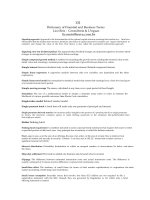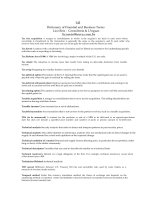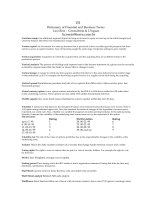dictionary of finance and investment terms 5th edition phần 1 doc
Bạn đang xem bản rút gọn của tài liệu. Xem và tải ngay bản đầy đủ của tài liệu tại đây (4.25 MB, 75 trang )
cover next page >
title :
author :
publisher :
isbn10 | asin :
print isbn13 :
ebook isbn13 :
language :
subject
publication date :
lcc :
ddc :
subject :
cover next page >
< previous page page_i next page >
Page i
Dictionary of Finance and Investment Terms
Fifth Edition
John Downes
Editor, Beating the Dow
Former Vice President, AVCO Financial Services, Inc.
Office for Economic Development, City of New York
Jordan Elliot Goodman
Financial Analyst, NBC News at Sunrise
Author, Everyone's Money Book
Creator, The Money Answers Program
Former Wall Street Correspondent,
MONEY Magazine, Time Warner Incorporated
Former Business News Commentator,
Mutual Broadcasting System
< previous page page_i next page >
< previous page page_ii next page >
Page ii
© Copyright 1998 by Barron's Educational Series, Inc.
Prior editions © Copyright 1985, 1987, 1991, 1995
by Barron's Educational Series, Inc.
All rights reserved.
No part of this book may be reproduced in any form, by photostat, microfilm, xerography, or any other means, or
incorporated into any information retrieval system, electronic or mechanical, without the written permission of the
copyright owner.
All inquiries should be addressed to:
Barron's Educational Series, Inc.
250 Wireless Boulevard
Hauppauge, NY 11788
Library of Congress Catalog Card No. 98-38302
International Standard Book No. 0-7641-0790-9
Library of Congress Cataloging-in-Publication Data
Downes, John, 1936
Dictionary of finance and investment terms / John Downes, Jordan
Elliot Goodman. 5th ed.
p. cm.
ISBN 0-7641-0790-9
1. Finance Dictionaries. 2. InvestmentsDictionaries.
I. Goodman, Jordan Elliot. II. Title.
HG151.D69 1998
332'.03dc21 98-38302
CIP
PRINTED IN THE UNITED STATES OF AMERICA
987
< previous page page_ii next page >
< previous page page_iii next page >
Page iii
Contents
Preface to the Fifth Edition iv
How to Use This Book Effectively vi
Terms 1
Abbreviations and Acronyms 717
< previous page page_iii next page >
< previous page page_iv next page >
Page iv
Preface to the Fifth Edition
People retiring in the early years of the 21st century, the baby boom generation, have witnessed a revolution in the
world of finance and investment. The forces of globalization assure that their children, face a future just as dynamic.
Deregulation of the securities, banking, and savings industries, starting in the 1970s, made a vast range of financial
and investment products and services available to people at all economic levels. It also led to abuses and financial
losses that required government intervention and a modernization of investor safeguards.
Merger mania in the "roaring 1980s" saw many of America's best-known corporations embroiled in hostile takeovers
or leveraged buyouts financed by junk bonds, giving rise to defensive tactics known by such colorful names as the
"poison pill," the "Pac-Man strategy," or the "white knight." Insider trading scandals were one result, but another was
the innovation of investment techniques designed to capitalize on the profit opportunities created by corporate
takeovers.
The 1990s brought corporate downsizing and restructuring, massive stock buybacks, strategic mergers on a global
scale, and a prolonged bull market fueled by corporate profitability, low inflation, and sustained economic growth.
With globalization, the world's economies, more free of trade and economic barriers, have become more
interdependent and in some ways more vulnerable. On the eve of the new millennium, floundering Asian economies
and a recession in Japan threatened markets in the United States and challenged the confidence of a new European
Monetary Union with its common currency, the Euro, and its promise of expanded financial markets.
Advanced communications systems have created both greater simplicity and greater complexity in the more unified
world of finance and investment. By linking markets and processing massive information, these systems have given
rise to investment vehicles, transactions, and methods of managing risk not previously imaginable.
The generation produced by the baby boomers must plan its personal finances in an economy offering less assurance
of future financial security. The restructurings of the 1990s made corporations more efficient but took their human
toll, just as the demographics that earlier created surpluses in the Social Security system became less favorable for
future recipients. The enormous growth of 401(k) and individual retirement accounts, addresses this problem but also
points to its gravity.
The introduction of Roth IRAs, the lowering of long-term capital gains tax rates, and other provisions of the
Taxpayer Relief Act of 1997 and the IRS Restructuring and Reform Act of 1998, also recognize the increasing
importance of self-reliance in personal financial planning.
This thoroughly revised Dictionary of Finance and Investment Terms covers the 20th century's major developments
in investments, taxation, economics, consumer and corporate finance, and related fields. Adding a more
comprehensive global dimension, it defines and clarifies the language that will be used in financial decision-making
in the new millennium.
< previous page page_iv next page >
< previous page page_v next page >
Page v
We wish especially to acknowledge Roberta Yafie, whose fact-checking and research went well beyond the call of
duty; Mary Falcon, Barron's editor, who ably and patiently coordinated an immense amount of detail; and our
original Barron's editor, Tom Hirsch. Suzanne and Jason Goodman, Katie and Annie Downes, and Nancy Weinberg
all sacrificed unselfishly at different stages of the project and we thank them.
We also thank Accounting Today, American Association of Individual Investors, American Bankers Association,
American Council of Life Insurance, American Express Company, American Institute of Certified Public
Accountants, American Society of CLU & ChFC (Chartered Life Underwriters), American Stock Exchange,
Associated Credit Bureaus, Bankers Trust Company,
A.M. Best & Company, The Bond Buyer, Bond Market Association, Boston Stock Exchange, Chase Manhattan
Bank NA, Chicago Board of Trade, Chicago Board Options Exchange, Chicago Mercantile Exchange, Cincinnati
Stock Exchange, Coffee, Sugar & Cocoa Exchange, COMEX, Commodity Futures Trading Commission, Dow Jones
& Company, Employee Benefit Research Institute, The European Commission, Fannie Mae, Federal Energy
Regulatory Commission, Federal Reserve Bank of New York, Federal Trade Commission, FINEX, Frank Russell
Company, Futures Industry Association, Goldman Sachs & Company, Health Insurance Institute of America, Hulbert
Financial Digest, IBC Organization, I/B/E/S Incorporated, Insurance Information Institute, Intermarket Management
Incorporated, Internal Revenue Service, International Petroleum Exchange, International Swaps and Derivatives
Association, Investment Management Consultants Association, Investment Program Association, J.P. Morgan,
Kansas City Board of Trade, Richard J. Kittrell, Esq/ Kittrell & Kittrell P.C., Liquidity Financial Corporation,
Mercer and Company, Merrill Lynch, Minneapolis Grain Exchange, Montreal Exchange/Bourse de Montreal,
Morgan Stanley Dean Witter, Morningstar, Mortgage Bankers Association, Municipal Bond Investors Assurance
Corporation, National Association of Investors Corporation, National Association of Real Estate Investment Trusts,
National Association of Realtors, National Association of Securities Dealers, National Association of Variable
Annuities, National Credit Union Administration, New York Cotton Exchange, New York Futures Exchange, New
York Life Insurance Company, New York Mercantile Exchange, New York Stock Exchange, Office of Thrift
Supervision, Options Clearing Corporation, Options Institute, Pacific Exchange, Pension Benefit Guaranty
Corporation, Philadelphia Stock Exchange, Prudential Securities, Salomon Smith Barney, Securities and Exchange
Commission, Securities Industry Association, Standard & Poor's, Toronto Stock Exchange, Trimedia Incorporated,
U.S. Department of Commerce, U.S. Department of Labor, Value Line Investment Survey, Vancouver Stock
Exchange, Visa International, The Weiser Group, Wheat First Butcher Singer Incorporated, Wilshire Associates,
Winnipeg Commodity Exchange, World Gold Council, Wrap Industry Association, and Zacks Investment Research.
JOHN DOWNES
JORDAN ELLIOT GOODMAN
< previous page page_v next page >
< previous page page_vi next page >
Page vi
How to Use This Book Effectively
Alphabetization: All entries are alphabetized by letter rather than by word so that multiple-word terms are treated as
single words. For example, NET ASSET VALUE follows NET ASSETS as though it were spelled
NETASSETVALUE, without spacing. Similarly, ACCOUNT EXECUTIVE follows ACCOUNTANT'S OPINION.
In unusual cases, abbreviations or acronyms appear as entries in the main text, in addition to appearing in the back of
the book in the separate listing of Abbreviations and Acronyms. This is when the short form, rather than the formal
name, predominates in common business usage. For example, NASDAQ is more commonly used in speaking of the
National Association of Securities Dealers Automated Quotations system than the name itself, so the entry is at
NASDAQ. Numbers in entry titles are alphabetized as if they were spelled out.
Abbreviations and Acronyms: A separate list of abbreviations and acronyms follows the Dictionary. It contains
shortened versions of terms defined in the book, plus several hundred related business terms.
Cross references: In order to gain a fuller understanding of a term, it will sometimes help to refer to the definition of
another term. In these cases the additional term is printed in SMALL CAPITALS. Such cross references appear in
the body of the definition or at the end of the entry (or sub-entry). Cross references at the end of an entry (or sub-
entry) may refer to related or contrasting concepts rather than give more information about the concept under
discussion. As a rule, a term is printed in small capitals only the first time it appears in an entry. Where an entry is
fully defined at another entry, a reference rather than a definition is provided; for example, EITHER-OR ORDER see
ALTERNATIVE ORDER.
Italics: Italic type is generally used to indicate that another term has a meaning identical or very closely related to
that of the entry. Occasionally, italic type is also used to highlight the fact that a word used is a business term and not
just a descriptive phrase. Italics are also used for the titles of publications.
Parentheses: Parentheses are used in entry titles for two reasons. The first is to indicate that an entry's opposite is
such an integral part of the concept that only one discussion is necessary; for example, REALIZED PROFIT (OR
LOSS). The second and more common reason is to indicate that an abbreviation is used with about the same
frequency as the term itself; for example, OVER THE COUNTER (OTC).
Examples, Illustrations, and Tables: The numerous examples in this Dictionary are designed to help readers gain
understanding and to help them relate abstract concepts to the real world of finance and investment. Line drawings
are provided in addition to text to clarify concepts best understood visually; for example, technical chart patterns
used by securities analysts and graphic concepts used in financial analysis.
< previous page page_vi next page >
< previous page page_1 next page >
Page 1
A
ABANDONMENT voluntarily giving up all rights, title, or claims to property that rightfully belongs to the owner.
An example of abandoned property would be stocks, bonds, or mutual funds held in a brokerage account for which
the firm is unable to locate the listed owner over a specified period of time, usually a few years. If ruled to be
abandoned, the property may revert to the state under the laws of ESCHEAT. In addition to financial assets, other
kinds of property that are subject to abandonment include patents, inventions, leases, trademarks, contracts, and
copyrights.
ABC AGREEMENT agreement between a brokerage firm and one of its employees spelling out the firm's rights
when it purchases a New York Stock Exchange membership for the employee. Only individuals can be members of
the NYSE, and it is common practice for a firm to finance the purchase of a membership, or SEAT, by one of its
employees. The NYSE-approved ABC Agreement contains the following provisions regarding the future disposition
of the seat: (1) The employee may retain the membership and buy another seat for an individual designated by the
firm. (2) The employee may sell the seat and give the proceeds to the firm. (3) The employee may transfer the seat to
another employee of the firm.
ABILITY TO PAY
Finance: borrower's ability to meet principal and interest payments on long-term obligations out of earnings. Also
called ability to service. See also FIXED CHARGE COVERAGE.
Industrial relations: ability of an employer, especially a financial organization to meet a union's financial demands
from operating income.
Municipal bonds: issuer's present and future ability to generate enough tax revenue to meet its contractual
obligations, taking into account all factors concerned with municipal income and property values.
Taxation: the concept that tax rates should vary with levels of wealth or income; for example, the progressive income
tax.
ABOVE PAR see PAR VALUE.
ABS see AUTOMATED BOND SYSTEM.
ABSOLUTE PRIORITY RULE see BANKRUPTCY.
ABSORBED
Business: a cost that is treated as an expense rather than passed on to a customer.
Also, a firm merged into an acquiring company.
Cost accounting: indirect manufacturing costs (such as property taxes and insurance) are called absorbed costs. They
are differentiated from
< previous page page_1 next page >
< previous page page_2 next page >
Page 2
variable costs (such as direct labor and materials). See also DIRECT OVERHEAD.
Finance: an account that has been combined with related accounts in preparing a financial statement and has lost its
separate identity. Also called absorption account or adjunct account.
Securities: issue that an underwriter has completely sold to the public.
Also, in market trading, securities are absorbed as long as there are corresponding orders to buy and sell. The market
has reached the absorption point when further assimilation is impossible without an adjustment in price. See also
UNDIGESTED SECURITIES.
ABUSIVE TAX SHELTER LIMITED PARTNERSHIP the Internal Revenue Service deems to be claiming illegal
tax deductionstypically, one that inflates the value of acquired property beyond its fair market value. If these write-
offs are denied by the IRS, investors must pay severe penalties and interest charges, on top of back taxes.
ACCELERATED COST RECOVERY SYSTEM (ACRS) provision instituted by the ECONOMIC RECOVERY
TAX ACT OF 1981 (ERTA) and modified by the TAX REFORM ACT OF 1986, which established rules for the
DEPRECIATION (the recovery of cost through tax deductions) of qualifying assets within a shorter period than the
asset's expected useful (economic) life. With certain exceptions, ACRS rules provided for greater acceleration over
longer periods of time than ERTA rules, and were effective for property placed in service between 1980 and 1987.
See also MODIFIED ACCELERATED COST RECOVERY SYSTEM.
ACCELERATED DEPRECIATION Internal Revenue Service-approved methods used in the DEPRECIATION of
fixed assets placed in service prior to 1980 when the ACCELERATED COST RECOVERY SYSTEM (ACRS)
became mandatory. Such methods provided for faster recovery of cost and earlier tax advantages than traditional
STRAIGHT LINE DEPRECIATION and included such methods as DOUBLE-DECLINING BALANCE METHOD
(now used in some ACRS classes) and SUM-OF-THEYEARS' DIGITS METHOD.
ACCELERATION CLAUSE provision, normally present in an INDENTURE agreement, mortgage, or other
contract, that the unpaid balance is to become due and payable if specified events of default should occur. Such
events include failure to meet interest, principal, or sinking fund payments; insolvency; and nonpayment of taxes on
mortgaged property.
ACCEPTANCE
In general: agreement created when the drawee of a TIME DRAFT (bill of exchange) writes the word "accepted"
above the signature and designates a date of payment. The drawee becomes the acceptor, responsible for payment at
maturity.
Also, paper issued and sold by sales finance companies, such as General Motors Acceptance Corporation.
< previous page page_2 next page >
< previous page page_3 next page >
Page 3
Banker's acceptance: time draft drawn on and accepted by a bank, the customary means of effecting payment for
merchandise sold in import-export transactions and a source of financing used extensively in international trade.
With the credit strength of a bank behind it, the banker's acceptance usually qualifies as a MONEY MARKET
instrument. The liability assumed by the bank is called its acceptance liability. See also LETTER OF CREDIT.
Trade acceptance: time draft drawn by the seller of goods on the buyer, who becomes the acceptor, and which is
therefore only as good as the buyer's credit.
ACCOMMODATIVE MONETARY POLICY Federal Reserve policy to increase the amount of money available for
lending by banks. When the Fed implements an accommodative policy, it is known as easing the money supply.
During a period of easing, interest rates fall, making it more attractive for borrowers to borrow, thereby stimulating
the economy. The Fed will initiate an accommodative policy when interest rates are high, the economy is weak, and
there is little fear of an outbreak of inflation. Once interest rates have been lowered enough to stimulate the economy,
the Fed may become concerned about inflation again and switch to a TIGHT MONEY policy. See also
MONETARY POLICY.
ACCOUNT
In general: contractual relationship between a buyer and seller under which payment is made at a later time. The term
open account or charge account is used, depending on whether the relationship is commercial or personal.
Also, the historical record of transactions under the contract, as periodically shown on the statement of account.
Banking: relationship under a particular name, usually evidenced by a deposit against which withdrawals can be
made. Among them are demand, time, custodial, joint, trustee, corporate, special, and regular accounts.
Administrative responsibility is handled by an account officer.
Bookkeeping: assets, liabilities, income, and expenses as represented by individual ledger pages to which debit and
credit entries are chronologically posted to record changes in value. Examples are cash, accounts receivable, accrued
interest, sales, and officers' salaries. The system of recording, verifying, and reporting such information is called
accounting. Practitioners of accounting are called accountants.
Investment banking: financial and contractual relationship between parties to an underwriting syndicate, or the status
of securities owned and sold.
Securities: relationship between a broker-dealer firm and its client wherein the firm, through its registered
representatives, acts as agent in buying and selling securities and sees to related administrative matters. See also
ACCOUNT EXECUTIVE; ACCOUNT STATEMENT.
ACCOUNTANT'S OPINION statement signed by an independent public accountant describing the scope of the
examination of an organization's
< previous page page_3 next page >
< previous page page_4 next page >
Page 4
books and records. Because financial reporting involves considerable discretion, the accountant's opinion is an
important assurance to a lender or investor. Depending on the scope of an audit and the auditor's confidence in the
veracity of the information, the opinion can be unqualified or, to some degree, qualified. Qualified opinions, though
not necessarily negative, warrant investigation. Also called auditor's certificate.
ACCOUNT BALANCE net of debits and credits at the end of a reporting period. Term applies to a variety of
account relationships, such as with banks, credit card companies, brokerage firms, and stores, and to classifications
of transactions in a bookkeeping system. The same account may be an asset account balance or a liability account
balance, depending on which side of the transaction you are on. For example, your bank balance is an asset account
to you and a liability account to the bank. Your credit card (debit) balance is a liability account to you and an asset
account (account receivable) to the credit card company.
ACCOUNT EXECUTIVE brokerage firm employee who advises and handles orders for clients and has the legal
powers of an AGENT. Every account executive must pass certain tests and be registered with the NATIONAL
ASSOCIATION OF SECURITIES DEALERS (NASD) before soliciting orders from customers. Also called
registered representative. See also BROKER.
ACCOUNTING PRINCIPLES BOARD (APB) board of the American Institute of Certified Public Accountants
(AICPA) that issued (195973) a series of ACCOUNTANT'S OPINIONS constituting much of what is known as
GENERALLY ACCEPTED ACCOUNTING PRINCIPLES. See also FINANCIAL ACCOUNTING STANDARDS
BOARD (FASB).
ACCOUNT RECONCILIATION the process of adjusting the balance in your checkbook to match your bank
statement. Your checkbook balance, plus outstanding checks, less bank charges, plus interest (if any), should equal
the balance shown on your bank statement.
ACCOUNTS PAYABLE amounts owing on open account to creditors for goods and services. Analysts look at the
relationship of accounts payable to purchases for indications of sound day-to-day financial management. See also
TRADE CREDIT.
ACCOUNTS RECEIVABLE money owed to a business for merchandise or services sold on open account, a key
factor in analyzing a company's LIQUIDITYits ability to meet current obligations without additional revenues. See
also ACCOUNTS RECEIVABLE TURNOVER; AGING SCHEDULE; COLLECTION RATIO.
ACCOUNTS RECEIVABLE FINANCING short-term financing whereby accounts receivable serve as collateral for
working capital advances. See also FACTORING.
ACCOUNTS RECEIVABLE TURNOVER ratio obtained by dividing total credit sales by accounts receivable. The
ratio indicates how many
< previous page page_4 next page >
< previous page page_5 next page >
Page 5
times the receivables portfolio has been collected during the accounting period. See also ACCOUNTS
RECEIVABLE; AGING SCHEDULE; COLLECTION RATIO.
ACCOUNT STATEMENT
In general: any record of transactions and their effect on charge or open-account balances during a specified period.
Banking: summary of all checks paid, deposits recorded, and resulting balances during a defined period. Also called
a bank statement.
Securities: statement summarizing all transactions and showing the status of an account with a broker-dealer firm,
including long and short positions. Such statements must be issued quarterly, but are generally provided monthly
when accounts are active. Also, the OPTION AGREEMENT required when an option account is opened.
ACCREDITED INVESTOR under Securities and Exchange Commission Regulation D, a wealthy investor who does
not count as one of the maximum of 35 people allowed to put money into a PRIVATE LIMITED PARTNERSHIP.
To be accredited, such an investor must have a net worth of at least $1 million or an annual income of at least
$200,000, or must put at least $150,000 into the deal, and the investment must not account for more than 20% of the
investor's worth. Private limited partnerships use accredited investors to raise a larger amount of capital than would
be possible if only 35 less-wealthy people could contribute.
ACCRETION
1. asset growth through internal expansion, acquisition, or such causes as aging of whisky or growth of timber.
2. adjustment of the difference between the price of a bond bought at an original discount and the par value of the
bond.
ACCRUAL BASIS accounting method whereby income and expense items are recognized as they are earned or
incurred, even though they may not have been received or actually paid in cash. The alternative is CASH BASIS
accounting.
ACCRUAL BONDS bonds that do not make periodic interest payments, but instead accrue interest until the bond
matures. Also known as zero-coupon bonds. See also ZERO-COUPON SECURITIES.
ACCRUED BENEFITS pension benefits that an employee has earned based on his or her years of service at a
company. See also VESTING.
ACCRUED INTEREST interest that has accumulated between the most recent payment and the sale of a bond or
other fixed-income security. At the time of sale, the buyer pays the seller the bond's price plus accrued interest,
calculated by multiplying the coupon rate by the number of days that have elapsed since the last payment.
Accrued interest is also used in a real estate LIMITED PARTNERSHIP when the seller of a building takes a lump
sum in cash at the time of
< previous page page_5 next page >
< previous page page_6 next page >
Page 6
sale and gives a second mortgage for the remainder. If the rental income from the building does not cover the
mortgage payments, the seller agrees to let the interest accrue until the building is sold to someone else. Accrued
interest deals were curtailed by the 1984 tax act.
ACCRUED MARKET DISCOUNT increase in market value of a DISCOUNT BOND that occurs because of its
approaching MATURITY DATE (when it is redeemable at PAR) and not because of declining market interest rates.
ACCUMULATED DIVIDEND dividend due, usually to holders of cumulative preferred stock, but not paid. It is
carried on the books as a liability until paid. See also CUMULATIVE PREFERRED.
ACCUMULATED PROFITS TAX surtax on earnings retained in a business to avoid the higher personal income
taxes they would be subject to if paid out as dividends to the owners.
Accumulations above the specified limit, which is set fairly high to benefit small firms, must be justified by the
reasonable needs of the business or be subject to the surtax. Because determining the reasonable needs of a business
involves considerable judgment, companies have been known to pay excessive dividends or even to make merger
decisions out of fear of the accumulated profits tax. Also called accumulated earnings tax.
ACCUMULATION
Corporate finance: profits that are not paid out as dividends but are instead added to the company's capital base. See
also ACCUMULATED PROFITS TAX.
Investments: purchase of a large number of shares in a controlled way so as to avoid driving the price up. An
institution's accumulation program, for instance, may take weeks or months to complete.
Mutual funds: investment of a fixed dollar amount regularly and reinvestment of dividends and capital gains.
ACCUMULATION AREA price range within which buyers accumulate shares of a stock. Technical analysts spot
accumulation areas when a stock does not drop below a particular price. Technicians who use the ON-BALANCE
VOLUME method of analysis advise buying stocks that have hit their accumulation area, because the stocks can be
expected to attract more buying interest. See chart on next page. See also DISTRIBUTION AREA.
ACES acronym for Advanced Computerized Execution System, run by the NASDAQ stock market. ACES automates
trades between order-entry and market-maker firms that have established trading relationships with each other,
designating securities at specified quantities for automatic execution. Once trading parameters are set, ACES
facilitates order entry, best-price order execution and limited-order maintenance, as well as a variety of inventory
control capabilities. Trades are then automatically reported for public dissemination and sent for comparison and
clearing.
< previous page page_6 next page >
< previous page page_7 next page >
Page 7
ACID-TEST RATIO See QUICK RATIO.
ACKNOWLEDGMENT verification that a signature on a banking or brokerage document is legitimate and has been
certified by an authorized person. Acknowledgment is needed when transferring an account from one broker to
another, for instance. In banking, an acknowledgment verifies that an item has been received by the paying bank and
is or is not available for immediate payment.
ACQUIRED SURPLUS uncapitalized portion of the net worth of a successor company in a POOLING OF
INTERESTS combination. In other words, the part of the combined net worth not classified as CAPITAL STOCK.
In a more general sense, the surplus acquired when a company is purchased.
ACQUISITION one company taking over controlling interest in another company. Investors are always looking out
for companies that are likely to be acquired, because those who want to acquire such companies are often willing to
pay more than the market price for the shares they need to complete the acquisition. See also MERGER; POOLING
OF INTERESTS; TAKEOVER.
ACQUISITION COST
Finance: price plus CLOSING COSTS to buy a company, real estate or other property.
Investments: SALES CHARGE incurred to buy a LOAD FUND or the original price, plus brokerage commissions,
of a security. See also TAX BASIS.
ACROSS THE BOARD movement in the stock market that affects almost all stocks in the same direction. When the
market moves up across the board, almost every stock gains in price.
< previous page page_7 next page >
< previous page page_8 next page >
Page 8
An across-the-board pay increase in a company is a raise of a fixed percent or amount for all employees.
ACTING IN CONCERT two or more investors working together to achieve the same investment goalfor example,
all buying stock in a company they want to take over. Such investors must inform the Securities and Exchange
Commission if they intend to oust the company's top management or acquire control. It is illegal for those acting in
concert to manipulate a stock's price for their own gain.
ACTIVE ACCOUNT account at a bank or brokerage firm in which there are many transactions. An active banking
account may generate more fees for each check written or ATM transaction completed. An active brokerage account
will generate more commission revenue for the brokerage firm than an inactive account. Banks usually impose
minimum charges for maintaining a checking and savings account. Many brokerage firms levy a fee if an account
does not generate a high enough level of activity. If there is no activity in an account for five years or more, the
account may be subject to ESCHEAT procedures in which the account's assets revert to the state.
ACTIVE BOND CROWD members of the bond department of the New York Stock Exchange responsible for the
heaviest volume of bond trading. The opposite of the active crowd is the CABINET CROWD, which deals in bonds
that are infrequently traded. Investors who buy and sell bonds in the active crowd will tend to get better prices for
their securities than in the inactive market, where spreads between bid and asked prices are wider.
ACTIVE BOX collateral available for securing brokers' loans or customers' margin positions in the placeor box
where securities are held in safekeeping for clients of a broker-dealer or for the broker-dealer itself. Securities used
as collateral must be owned by the firm or hypothecatedthat is, pledged or assignedby the customer to the firm, then
by the broker to the lending bank. For margin loans, securities must be hypothecated by the customer to the broker.
ACTIVE MARKET heavy volume of trading in a particular stock, bond, or commodity. The spread between bid and
asked prices is usually narrower in an active market than when trading is quiet.
Also, a heavy volume of trading on the exchange as a whole. Institutional money managers prefer such a market
because their trades of large blocks of stock tend to have less impact on the movement of prices when trading is
generally active.
ACTUALS any physical commodity, such as gold, soybeans, or pork bellies. Trading in actuals ultimately results in
delivery of the commodity to the buyer when the contract expires. This contrasts with trading in commodities of, for
example, index options, where the contract is settled in cash, and no physical commodity is delivered upon
< previous page page_8 next page >
< previous page page_9 next page >
Page 9
expiration. However, even when trading is in actuals most futures and options contracts are closed out before the
contract expires, and so these transactions do not end in delivery.
ACTUARY mathematician employed by an insurance company to calculate premiums, reserves, dividends, and
insurance, pension, and annuity rates, using risk factors obtained from experience tables. These tables are based on
both the company's history of insurance claims and other industry and general statistical data.
ADDITIONAL BONDS TEST test limiting the amount of new bonds that can be issued. Since bonds are secured by
assets or revenues of a corporate or governmental entity, the underwriters of the bond must insure that the bond
issuer can meet the debt service requirements of any additional bonds. The test usually sets specific financial
benchmarks, such as what portion of an issuer's revenues or cash flow can be devoted to paying interest.
ADDITIONAL PAID-IN CAPITAL see PAID-IN CAPITAL.
ADDITIONAL VOLUNTARY CONTRIBUTIONS contributions made by an employee into a tax-deferred savings
account, such as a 401(k) or 403(b), beyond the level at which an employer will match the investment. Depending on
the level of contributions, these may be made on a pretax or aftertax basis. Tax law limits the total amount of money
that can be contributed to such a tax-deferred account. In any case, all funds so contributed accumulate without
taxation until withdrawn at retirement. The employee chooses the investment vehicles in which the money is
invested.
ADEQUACY OF COVERAGE test of the extent to which the value of an asset, such as real property, securities, or a
contract subject to currency exchange rates, is protected from potential loss either through INSURANCE or
HEDGING.
ADJUSTABLE RATE MORTGAGE (ARM) mortgage agreement between a financial institution and a real estate
buyer stipulating predetermined adjustments of the interest rate at specified intervals. Mortgage payments are tied to
some index outside the control of the bank or savings and loan institution, such as the interest rates on U.S. Treasury
bills or the average national mortgage rate. Adjustments are made regularly, usually at intervals of one, three, or five
years. In return for taking some of the risk of a rise in interest rates, borrowers get lower rates at the beginning of the
ARM than they would if they took out a fixed rate mortgage covering the same term. A homeowner who is worried
about sharply rising interest rates should probably choose a fixed rate mortgage, whereas one who thinks rates will
rise modestly, stay stable, or fall should choose an adjustable rate mortgage. Critics of ARMs charge that these
mortgages entice young homeowners to undertake potentially onerous commitments.
< previous page page_9 next page >
< previous page page_10 next page >
Page 10
Also called a Variable Rate Mortgage (VRM), the ARM should not be confused with the GRADUATED
PAYMENT MORTGAGE, which is issued at a fixed rate with monthly payments designed to increase as the
borrower's income grows. See also CAP; COST OF FUNDS; GROWING EQUITY MORTGAGE; MORTGAGE
INTEREST DEDUCTION; SELF-AMORTIZING MORTGAGE; SHARED APPRECIATION MORTGAGE;
TEASER RATE.
ADJUSTABLE RATE PREFERRED STOCK (ARPS) PREFERRED STOCK, whose dividend instead of being
fixed is adjusted, usually quarterly, based on changes in the Treasury bill rate or other money market rate. The prices
of adjustable rate preferreds are less volatile than fixed rate preferreds. Also called floating rate or variable rate
preferred. See also CAPS; DUTCH AUCTION PREFERRED STOCK; MANDATORY CONVERTIBLES.
ADJUSTED BALANCE METHOD formula for calculating finance charges based on ACCOUNT BALANCE
remaining after adjusting for payments and credits posted during the billing period. Interest charges under this
method are lower than those under the AVERAGE DAILY, PREVIOUS BALANCE, and PAST DUE BALANCE
METHODS.
ADJUSTED BASIS base price from which to judge capital gains or losses upon sale of an asset like a stock or bond.
The cost of commissions in effect is deducted at the time of sale when net proceeds are used for tax purposes. The
price must be adjusted to account for any stock splits that have occurred since the initial purchase before arriving at
the adjusted basis.
ADJUSTED DEBIT BALANCE (ADB) formula for determining the position of a margin account, as required under
Regulation T of the Federal Reserve Board. The ADB is calculated by netting the balance owing the broker with any
balance in the SPECIAL MISCELLANEOUS ACCOUNT (SMA), and any paper profits on short accounts.
Although changes made in Regulation T in 1982 diminished the significance of ADBs, the formula is still useful in
determining whether withdrawals of cash or securities are permissible based on SMA entries.
ADJUSTED EXERCISE PRICE term used in put and call options on Government National Mortgage Association
(Ginnie Mae) contracts. To make sure that all contracts trade fairly, the final exercise price of the option is adjusted
to take into account the coupon rates carried on all GNMA mortgages. If the standard GNMA mortgage carries an
8% yield, for instance, the price of GNMA pools with 12% mortgages in them are adjusted so that both instruments
have the same yield to the investor.
ADJUSTED GROSS INCOME (AGI) income on which an individual or couple computes federal income tax. AGI is
determined by subtracting from gross income any unreimbursed business expenses and other allowable
adjustmentsfor example, INDIVIDUAL RETIREMENT
< previous page page_10 next page >
< previous page page_11 next page >
Page 11
ACCOUNTS, SEP and Keogh payments, and alimony payments. Other adjustments include: forfeiture of interest
penalties because of premature withdrawals from a certificate of deposit; capital loss deductions up to $3,000; rent
and royalty expenses; 50% of self-employed tax liability; health insurance deductions for the self-employed and net
operating losses. AGI is the individual's or couple's income before itemized deductions such as medical expenses,
state and local income taxes, and real estate taxes. Once AGI exceeds certain income thresholds detailed in the tax
code, some itemized deductions are disallowed. For example, for those married couples filing jointly in 1997 with
adjusted gross incomes over $121,200, itemized deductions are reduced by 3% of the excess of AGI, over $121,200.
These thresholds are adjusted upwards annually.
ADJUSTMENT BOND bond issued in exchange for outstanding bonds when recapitalizing a corporation that faces
bankruptcy. Authorization for the exchange comes from the bondholders, who consider adjustment bonds a lesser
evil. These bonds promise to pay interest only to the extent earned by the corporation. This gives them one of the
characteristics of income bonds, which trade flatthat is, without accrued interest.
ADMINISTRATOR court-appointed individual or bank charged with carrying out the court's decisions with respect
to a decedent's estate until it is fully distributed to all claimants. Administrators are appointed when a person dies
without having made a will or without having named an executor, or when the named executor cannot or will not
serve. The term administratrix is sometimes used if the individual appointed is a woman.
In a general sense, an administrator is a person who carries out an organization's policies.
AD VALOREM Latin term meaning ''according to value" and referring to a way of assessing duties or taxes on
goods or property. As one example, ad valorem DUTY assessment is based on value of the imported item rather than
on its weight or quantity. As another example, the city of Englewood, New Jersey, levies an ad valorem property tax
based on the assessed value of property rather than its size.
ADVANCE
Employee benefits: cash given to an employee before it is needed or earned. A travel advance is supplied so that an
employee has cash to use on an upcoming business trip. A salary advance is provided to help the employee cover
emergency expenses.
Securities: increase in the price of stocks, bonds, commodities, or other assets. Often heard when referring to the
movement of broad indexes, e.g., "The Dow Jones Industrials advanced 15 points today."
Trade: advance payment for goods or services that will be delivered in the near future. For example, home
contractors require an advance from homeowners to pay for building materials.
< previous page page_11 next page >
< previous page page_12 next page >
Page 12
ADVANCE-DECLINE (A-D) measurement of the number of stocks that have advanced and the number that have
declined over a particular period. It is the ratio of one to the other and shows the general direction of the market. It is
considered bullish if more stocks advance than decline on any trading day. It is bearish if declines outnumber
advances. The steepness of the A-D line graphically shows whether a strong bull or bear market is underway.
ADVANCED FUNDED PENSION PLAN pension plan under which assets are set aside in amounts and at times
approximately coincident with the accruing of benefit rights. In this way, funds are set aside in advance of the date of
retirement.
ADVANCE REFUNDING
Government securities: exchange of maturing government securities prior to their due date for issues with a later
maturity. It is through advance refunding that the national debt is extended as an alternative to the economic
disruptions that would result from eliminating the debt all at once.
Municipal bonds: sale of new bonds (the refunding issue) in advance, usually by some years, of the first call date of
the old bonds (the issue to be refunded). The refunding issue would normally have a lower rate than the issue to be
refunded, and the proceeds would be invested, usually in government securities, until the higher-rate bonds become
callable. This practice, also called pre-refunding, has been curtailed by several tax acts. See also REFUNDING
ESCROW DEPOSITS (REDS).
ADVERSE OPINION opinion expressed by a company's independent auditors that the firm's financial statements do
not accurately reflect the company's current financial position or operating results. An adverse opinion is a far more
serious finding than a QUALIFIED OPINION, in which only some issues are of concern to the auditor. Investors
< previous page page_12 next page >
< previous page page_13 next page >
Page 13
should be extremely cautious about investing in any company with an adverse opinion from its auditors.
ADVERSE SELECTION tendency of people with significant potential to file claims wanting to obtain insurance
coverage. For example, those with severe health problems want to buy health insurance, and people going to a
dangerous place such as a war zone want to buy more life insurance. Companies employing workers in dangerous
occupations want to buy more worker's compensation coverage. In order to combat the problem of adverse selection,
insurance companies try to reduce their exposure to large claims by either raising premiums or limiting the
availability of coverage to such applicants.
ADVISORY LETTER newsletter aiming to offer financial advice to subscribers. The letter may offer a broad
economic and market outlook, or it may focus on a particular sector of the stock, bond, or commodity markets. Some
advisory letters specialize in recommending only mutual funds. Some letters also advise their subscribers of new
recommendations through a toll-free hotline, which can be updated much more quickly than a printed letter. If the
advisory letter recommends specific securities, the author usually is registered with the Securities and Exchange
Commission as a REGISTERED INVESTMENT ADVISOR. See also HULBERT RATING.
AFFIDAVIT written statement made under oath before an authorized person, such as a notary public.
AFFIDAVIT OF DOMICILE AFFIDAVIT made by the executor of an estate that certifies the decedent's place of
residence at the time of death. Before securities can be transferred from an estate, it must be verified that no liens
exist against them in the home state of the decedent.
AFFILIATE
In general: two companies are affiliated when one owns less than a majority of the voting stock of the other, or when
both are subsidiaries of a third company. A SUBSIDIARY is a company of which more than 50% of the voting
shares are owned by another corporation, termed the PARENT COMPANY. A subsidiary is always, by definition, an
affiliate, but subsidiary is the preferred term when majority control exists. In everyday use, affiliate is the correct
word for intercompany relationships, however indirect, where the parent-subsidiary relationship does not apply.
Banking Act of 1933: any organization that a bank owns or controls by stock holdings, or which the bank's
shareholders own, or whose officers are also directors of the bank.
Internal Revenue Service: for purposes of consolidated tax returns an affiliated group is composed of companies
whose parent or other inclusive corporation owns at least 80% of voting stock.
Interstate Commerce Commission, Account 706: 1. Controlled by the accounting company alone or with others
under a joint agreement.
< previous page page_13 next page >
< previous page page_14 next page >
Page 14
2. Controlling the accounting company alone or with others under a joint agreement.
Investment Company Act: company in which there is any direct or indirect ownership of 5% or more of the
outstanding voting securities.
AFFILIATED CORPORATION corporation that is an AFFILIATE.
AFFILIATED PERSON individual in a position to exert direct influence on the actions of a corporation. Among
such persons are owners of 10% or more of the voting shares, directors, and senior elected officers and any persons
in a position to exert influence through them such as members of their immediate family and other close associates.
Sometimes called a control person.
AFFORDABILITY INDEX standard established by the National Association of Realtors (NAR) to gauge the
financial ability of consumers to buy a home. A reading of 100 means a family earning the national median family
income (reported by the Census Bureau) can qualify for a mortgage on a typical median-priced existing single-family
home. An index above 100 signifies that a family earning the median income more than qualifies for a mortgage loan
on a median-priced home, assuming a 20% downpayment. Therefore, an increase in the Affordability Index shows
that a family is more able to afford the median priced home. The prevailing mortgage interest rate is the effective rate
on loans closed on existing homes from the Federal Housing Finance Board (for the U.S.) and HSH Associates of
Butler, NJ (for various regions). The mortgage is based on an 80% loan (20% down payment) and a qualifying ratio
of 25%, meaning that 25% of the borrower's gross monthly income will be needed to cover housing costs, including
the mortgage. The 25% qualifying ratio covers expected principal and interest payments, but does not cover taxes
and insurance.
There are 3 different types of indices calculated by NAR. The Fixed Rate Index is based on the current effective
interest rate on 30-year fixed rate mortgages. The Adjustable Rate Index is calculated using the prevailing effective
interest rate on adjustable-rate mortgages. The Composite Index uses a weighted average of the interest rates on fixed
and adjustable rate mortgages, weighted by the relative proportion of fixed and adjustable rate loans closed on
existing homes.
NAR also calculates a first-time homebuyer Affordability Index, which recognizes the special characteristics of first-
time home buyers and the homes they purchase. The group most likely to purchase a first home consists of a young
renter family with a head of household aged 25 to 44 and a lower median income than the overall population. This
index assumes a 10% downpayment, and adds one quarter of a percentage point to the mortgage rate for the required
private mortgage insurance. The first-time home is calculated at 85% of the median price of all existing homes
purchased. Some economists maintain that every one-point increase in the home mortgage interest rate results in
300,000 fewer home sales.
< previous page page_14 next page >
< previous page page_15 next page >
Page 15
AFTER ACQUIRED CLAUSE clause in a mortgage agreement providing that any additional mortgageable property
acquired by the borrower after the mortgage is signed will be additional security for the obligation.
While such provisions can help give mortgage bonds a good rating and enable issuing corporations to borrow at
favorable rates, by precluding additional first mortgages, they make it difficult to finance growth through new
borrowings. This gives rise to various maneuvers to remove after acquired clauses, such as redemption or exchange
of bonds or changes in indenture agreements.
AFTER-HOURS DEALING OR TRADING trading of stocks and bonds after regular trading hours on organized
exchanges. This may occur when there is a major announcement about positive or negative earnings or a takeover at
a particular company. The stock price may therefore soar or plummet from the level at which it closed during regular
trading hours. Some brokerage firms specialize in making over-the-counter markets around the clock to
accommodate after-hours dealing. See MAKE A MARKET.
AFTERMARKET see SECONDARY MARKET.
AFTERTAX BASIS basis for comparing the returns on a corporate taxable bond and a municipal tax-free bond. For
example, a corporate bond paying 10% would have an aftertax return of 6.4% for someone in the 36% tax bracket.
So any municipal bond paying higher than
6.4% would yield a higher aftertax return.
AFTERTAX REAL RATE OF RETURN amount of money, adjusted for inflation, that an investor can keep, out of
the income and capital gains earned from investments. Every dollar loses value to inflation, so investors have to keep
an eye on the aftertax real rate of return whenever they commit their capital. By and large, investors seek a rate of
return that will match if not exceed the rate of inflation.
AGAINST THE BOX SHORT SALE by the holder of a LONG POSITION in the same stock. BOX refers to the
physical location of securities held in safekeeping. When a stock is sold against the box, it is sold short, but only in
effect. A short sale is usually defined as one where the seller does not own the shares. Here the seller does own the
shares (holds a long position) but does not wish to disclose ownership; or perhaps the long shares are too inaccessible
to deliver in the time required; or, prior to the TAXPAYER RELIEF ACT OF 1997, he may have been holding his
existing position to get the benefit of long-term capital gains tax treatment. In any event, when the sale is made
against the box, the shares needed to cover are borrowed, probably from a broker. This technique was eliminated as a
way to reduce tax liabilities in the TAXPAYER RELIEF ACT OF 1997. See also SELLING SHORT AGAINST
THE BOX.
AGED FAIL contract between two broker-dealers that is still not settled 30 days after the settlement date. At that
point the open balance no
< previous page page_15 next page >
< previous page page_16 next page >
Page 16
longer counts as an asset, and the receiving firm must adjust its capital accordingly.
AGENCY
In general: relationship between two parties, one a principal and the other an AGENT who represents the principal in
transactions with a third party.
Finance: certain types of accounts in trust institutions where individuals, usually trust officers, act on behalf of
customers. Agency services to corporations are related to stock purchases and sales. Banks also act as agents for
individuals.
Government: securities issued by government-sponsored entities and federally related institutions. Agency securities
are exempt from Securities and Exchange Commission (SEC) registration requirements. See also AGENCY
SECURITIES.
Investment: act of buying or selling for the account and risk of a client. Generally, an agent, or broker, acts as
intermediary between buyer and seller, taking no financial risk personally or as a firm, and charging a commission
for the service.
AGENCY SECURITIES securities issued by U.S. government-sponsored entities (GSEs) and federally related
institutions.
GSEs currently issuing securities comprise eight privately owned, publicly chartered entities created to reduce
borrowing costs for certain sectors of the economy, such as farmers, homeowners, and students. They include the
Federal Farm Credit Bank System, Farm Credit Financial Assistance Corporation, Federal Home Loan Bank,
FEDERAL HOME LOAN MORTGAGE CORPORATION, FEDERAL NATIONAL MORTGAGE
ASSOCIATION (FNMA), STUDENT LOAN MARKETING ASSOCIATION (SLMA), FINANCING
CORPORATION (FICO). GSEs issue discount notes (with maturities ranging from overnight to 360 days) and
bonds. With the exception of the Farm Credit Financial Assistance Corporation, GSE securities are not backed by the
full faith and credit of the U.S. government. Other GSEs that formerly issued directly now borrow from the
FEDERAL FINANCING BANK.
Federally related institutions are arms of the U.S. government and generally have not issued securities directly into
the marketplace since the Federal Financing Bank was established to meet their consolidated borrowing needs in
1973. They include the EXPORT-IMPORT BANK (EXIMBANK) of the United States, the Commodity Credit
Corporation, the Farmers Housing Administration, the General Services Administration, the GOVERNMENT
NATIONAL MORTGAGE ASSOCIATION (GNMA), the Maritime Administration, the Private Export Funding
Corporation, the Rural Electrification Administration, the Rural Telephone Bank, the SMALL BUSINESS
ADMINISTRATION (SBA), the Tennessee Valley Authority (TVA), and the Washington Metropolitan Area Transit
Authority. Except for the Private Export Funding Corporation and the TVA, federally related institution obligations
are backed by the full faith and credit of the U.S. government.
< previous page page_16 next page >
< previous page page_17 next page >
Page 17
Agency securities are exempt from SEC registration and from state and local income taxes.
See also FEDERAL FARM CREDIT SYSTEM; FEDERAL HOME LOAN BANK SYSTEM.
AGENT individual authorized by another person, called the principal, to act in the latter's behalf in transactions
involving a third party. Banks are frequently appointed by individuals to be their agents, and so authorize their
employees to act on behalf of principals. Agents have three basic characteristics:
1. They act on behalf of and are subject to the control of the principal.
2. They do not have title to the principal's property.
3. They owe the duty of obedience to the principal's orders. See also ACCOUNT EXECUTIVE; BROKER;
TRANSFER AGENT.
AGGREGATE EXERCISE PRICE in stock options trading, the number of shares in a put or call CONTRACT
(normally 100) multiplied by the EXERCISE PRICE. The price of the option, called the PREMIUM, is a separate
figure not included in the aggregate exercise price. A July call option on 100 XYZ at 70 would, for example, have an
aggregate exercise price of 100 (number of shares) times $70 (price per share), or $7000, if exercised on or before
the July expiration date.
In options traded on debt instruments, which include GOVERNMENT NATIONAL MORTGAGE ASSOCIATION
(GNMA) pass-throughs, Treasury bills, Treasury notes, Treasury bonds, and certain municipal bonds, the aggregate
exercise price is determined by multiplying the FACE VALUE of the underlying security by the exercise price. For
example, the aggregate exercise price of put option Treasury bond December 90 would be $90,000 if exercised on or
before its December expiration date, the calculation being 90% times the $100,000 face value of the underlying
bond.
AGGREGATE SUPPLY in MACROECONOMICS, the total amount of goods and services supplied to the market at
alternative price levels in a given period of time; also called total output. The central concept in SUPPLY-SIDE
ECONOMICS, it corresponds with aggregate demand, defined as the total amount of goods and services demanded
in the economy at alternative income levels in a given period, including both consumer and producers' goods;
aggregate demand is also called total spending. The aggregate supply curve describes the relationship between price
levels and the quantity of output that firms are willing to provide.
AGGRESSIVE GROWTH MUTUAL FUND mutual fund holding stocks of rapidly growing companies. While these
companies may be large or small, they all share histories of and prospects for above-average profit growth.
Aggressive growth funds are designed solely for capital appreciation, since they produce little or no income from
dividends. This type of mutual fund is typically more volatile than the
< previous page page_17 next page >
< previous page page_18 next page >
Page 18
overall stock market, meaning its shares will rise far more than the average stock during bull markets and will fall
much farther than the typical stock in a bear market. Investors in aggressive growth funds must realize that the value
of their shares will fluctuate sharply over time. Aggressive growth funds are also called maximum capital gains funds
or capital appreciation funds.
AGING SCHEDULE classification of trade ACCOUNTS RECEIVABLE by date of sale. Usually prepared by a
company's auditor, the aging, as the schedule is called, is a vital tool in analyzing the quality of a company's
receivables investment. It is frequently required by grantors of credit.
The schedule is most often seen as: (1) a list of the amount of receivables by the month in which they were created;
(2) a list of receivables by maturity, classified as current or as being in various stages of delinquency. The following
is a typical aging schedule.
dollars (in thousands)
Current (under 30 days) $14,065 61%
130 days past due 3,725 16
3160 days past due 2,900 12
6190 days past due 1,800 8
Over 90 days past due 750 3
$23,240 100%
The aging schedule reveals patterns of delinquency and shows where collection efforts should be concentrated. It
helps in evaluating the adequacy of the reserve for BAD DEBTS, because the longer accounts stretch out the more
likely they are to become uncollectible. Using the schedule can help prevent the loss of future sales, since old
customers who fall too far behind tend to seek out new sources of supply.
AGREEMENT AMONG UNDERWRITERS contract between participating members of an investment banking
SYNDICATE; sometimes called syndicate contract or purchase group agreement. It is distinguished from the
underwriting agreement, which is signed by the company issuing the securities and the SYNDICATE MANAGER,
acting as agent for the underwriting group.
The agreement among underwriters, (1) appoints the originating investment banker as syndicate manager and agent;
(2) appoints additional managers, if considered advisable; (3) defines the members' proportionate liability (usually
limited to the amount of their participation) and agrees to pay each member's share on settlement date; (4) authorizes
the manager to form and allocate units to a SELLING GROUP, and agrees to abide by the rules of the selling group
agreement; (5) states the life of the syndicate, usually running until 30 days after termination of the selling group, or
ending earlier by mutual consent.
AIR POCKET STOCK stock that falls sharply, usually in the wake of such negative news as unexpected poor
earnings. As shareholders rush
< previous page page_18 next page >
